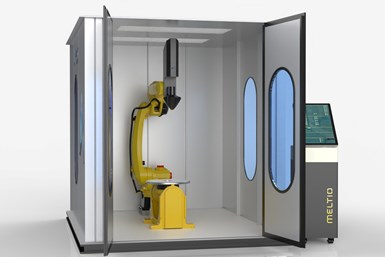AddiTec Develops Portable Additive Manufacturing Robot Cell
The AMRC – P (Additive Manufacturing Robot Cell – Portable) is capable of printing parts up to 1.8 meters in dimension in a wide range of materials, including titanium.
Share
AdditTec, a provider of metal additive manufacturing (AM) solutions and applications, has created a portable AM robot production cell. It is said the AMRC – P (Additive Manufacturing Robot Cell – Portable) is a highly capable, turnkey robotic metal AM system.
The cell provides all the benefits of a robotic architecture in a compact, welded cell. The system is capable of printing parts up to 1.8 meters in dimension in a wide range of materials, including titanium. The AMRC – P can be customized with any industrial robot to fit a company’s specific needs.
The company says the system features state-of-the-art software tools to accommodate complex multi-axis geometries, making the printing process easier and more accessible for both experienced and new users. Also, the software is highly customizable, enabling users to meet all their parameter requirements.
“AddiTec developed the AMRC – P to address what we saw as a strong demand in the market for a low-cost, turnkey robotic AM solution with the added flexibility of portability,” says Tilip Thiyagarajan, AddiTec business manager. “We are excited to bring this disruptive product to the market together with our in-depth applications and technical support experience.”
AddiTec is a founding partner in Meltio and serves as the master reseller of Meltio products in North America. It has comprehensive process knowledge and applications experience across a broad range of industrial sectors. It also offers high-end applications services to solve manufacturing challenges and promote the benefits of multilaser DED technology.
- Learn about AddiTec’s collaboration with Minnesota State University, Mankato (MSU) to develop biocompatible bone implants.
Related Content
-
3D Printed NASA Thrust Chamber Assembly Combines Two Metal Processes: The Cool Parts Show #71
Laser powder bed fusion and directed energy deposition combine for an integrated multimetal rocket propulsion system that will save cost and time for NASA. The Cool Parts Show visits NASA’s Marshall Space Flight Center.
-
DMG MORI: Build Plate “Pucks” Cut Postprocessing Time by 80%
For spinal implants and other small 3D printed parts made through laser powder bed fusion, separate clampable units resting within the build plate provide for easy transfer to a CNC lathe.
-
Additive Manufacturing Is Subtractive, Too: How CNC Machining Integrates With AM (Includes Video)
For Keselowski Advanced Manufacturing, succeeding with laser powder bed fusion as a production process means developing a machine shop that is responsive to, and moves at the pacing of, metal 3D printing.















